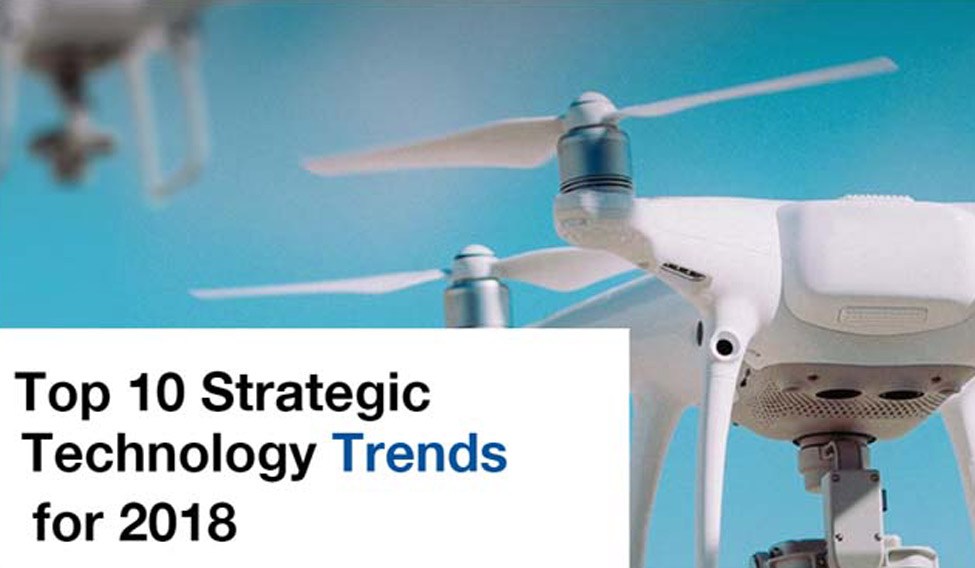The top strategic technology trends in 2018 will work in unison to create a huge intelligent digital mesh that will drive future business, predicts tech watcher Gartner. At its annual Symposium cum IT expo in Orlando, US, this week, experts suggested that trends like Artificial Intelligence, will broaden in scope to embrace a wide spectrum of intelligent 'things', while the so called Cloud, will edge closer to the sources of information.
Gartner will steer a discussion on more India-centric aspects of these projected trends at an edition of this conference scheduled in Goa, in November.
What is a strategic trend? It is defined as one which has the potential to break free of existing state and see broader use and impact. Gartner calls the entwining of people, devices, content and services the intelligent digital mesh and warns: "IT leaders must factor these technology trends into their innovation strategies or risk losing ground to those that do."
The top ten strategic tech trends to expect in 2018 are:
Trend 1: AI Foundation:
The ability to use Artificial Intelligence, to enhance decision making, reinvent business models and ecosystems, and remake the customer experience will drive the payoff for digital initiatives through 2025. Enterprises should focus on Narrow AI, consisting of highly scoped machine-learning solutions that target a specific task (such as understanding language or driving a vehicle in a controlled environment) and leave general AI to researchers and science fiction writer suggests Gartner Vice President David Cearley.
Trend 2: Intelligent Apps and Analytics
Over the next few years, every app, application and service will incorporate AI at some level. AI will run unobtrusively in the background of many familiar application categories while giving rise to entirely new ones. AI has become the next major battleground in a wide range of software and service markets, including aspects of Enterprise Resource Planning.
Trend 3: Intelligent Things
Intelligent things use AI and machine learning to interact in a more intelligent way with people and surroundings. Some intelligent things wouldn’t exist without AI, but others are existing things (i.e., a camera) that AI makes intelligent (i.e., a smart camera.) These things operate semi-autonomously or autonomously in an unsupervised environment. Examples include a self-directing vacuum or autonomous farming vehicle. As intelligent things proliferate, we should expect a shift from stand-alone intelligent things to a swarm of collaborative intelligent things.. like drones.
Trend 4: Digital Twins
A digital twin is a digital representation of a real-world entity or system. They are linked to real-world objects and offer information on the state of the counterparts, respond to changes, improve operations and add value. With an estimated 21 billion connected sensors and endpoints by 2020, digital twins will exist for billions of things in the near future. City planners, digital marketers, healthcare professionals and industrial planners will all benefit from this long-term shift to the integrated digital twin world.” For example, future models of humans could offer biometric and medical data, and digital twins for entire cities will allow for advanced simulations.
Trend 5: Cloud to the Edge
Edge computing describes a situation in which information processing and content collection and delivery are placed closer to the sources of this information. Cloud and edge computing are not competing approaches. When implemented together, cloud is used to create the service-oriented model and edge computing offers a delivery style that allows for executions of disconnected aspects of cloud service.
Trend 6: Conversational Platforms
Conversational platforms will drive a paradigm shift in which the burden of translating intent shifts from user to computer. These systems are capable of simple answers (How’s the weather?) or more complicated interactions (book a reservation at the Italian restaurant.) These platforms will continue to evolve to even more complex actions, such as collecting oral testimony from crime witnesses and acting on that information by creating a sketch of the suspect’s face based on the testimony.
Trend 7: Immersive Experience
Augmented Reality (AR), virtual reality (VR) and mixed reality are changing the way that people perceive and interact with the digital world. Combined with conversational platforms, a fundamental shift in the user experience to an invisible and immersive experience will emerge. Over the next five years the focus will be on mixed reality, which is emerging as the immersive experience of choice, where the user interacts with digital and real world objects while maintaining a presence in the physical world. Mixed reality exists along a spectrum and includes head-mounted displays (HMD) for AR or VR, as well as smartphone and tablet-based AR. Given the ubiquity of mobile devices, Apple’s release of ARkit and iPhone X, Google’s Tango and ARCore, and the availability of cross-platform AR software development kits such as Wikitude, Gartner expects the battles for smartphone-based AR and MR to heat up in 2018.
Trend 8: Blockchain
Blockchain is a shared, distributed, decentralised and tokenised ledger that allows untrusted parties to exchange commercial transactions. The technology holds the promise to change industries, and although the conversation often surrounds financial opportunities, blockchain has many potential applications in government, healthcare, content distribution, supply chain and more. However, many blockchain technologies are immature and unproven, and are largely unregulated.
Trend 9: Event-Driven
Digital businesses rely on the ability to sense and be ready to exploit new digital business moments. Business events reflect the discovery of notable states or state changes, such as completion of a purchase order. With the advent of AI, the IoT, and other technologies, business events can be detected more quickly and analyzed in greater detail. Enterprises should embrace “event thinking” as part of a digital business strategy.
Trend 10: Continuous Adaptive Risk and Trust
Digital business creates a complex, evolving security environment. The use of increasingly sophisticated tools increases the threat potential. Continuous adaptive risk and trust assessment or CARTA, allows for real-time, risk and trust-based decision making with adaptive responses to security-enable digital business. Traditional security techniques using ownership and control rather than trust will not work in the digital world.





